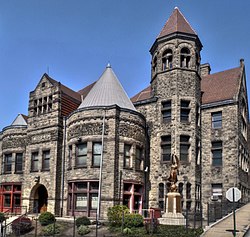Carnegie Free Library of Braddock
|
Braddock Carnegie Library
|
|

Braddock Carnegie Library. Elements to the left, including the round turret, are William Halsey Wood's 1889 facade. The octagonal tower beside the turret, and elements to its right, reflect the Longfellow, Alden & Harlow addition from 1893. The Frank Vittor statue, "Winged Victory", a WWI memorial, was added to the courtyard ca. 1922.
|
|
| Location | 419 Library St., Braddock, Pennsylvania |
|---|---|
| Coordinates | 40°24′6.73″N 79°51′55.53″W / 40.4018694°N 79.8654250°WCoordinates: 40°24′6.73″N 79°51′55.53″W / 40.4018694°N 79.8654250°W |
| Area | 2 acres (0.81 ha) |
| Built | 1888 |
| Architect | William Halsey Wood (1888); Longfellow, Alden & Harlow (1893 addition) |
| Architectural style | Romanesque Revival, Richardsonian Romanesque |
| NRHP Reference # | 73001585 |
| Significant dates | |
| Added to NRHP | June 19, 1973 |
| Designated NHL | March 6, 2012 |
| Designated PHLF | 1976 |
The Braddock Carnegie Library in Braddock, Pennsylvania, is the first Carnegie Library in the United States. As such, the library was named a National Historic Landmark in 2012, following its listing on the National Register of Historic Places in 1973, and is on the Pittsburgh History and Landmarks Foundation's List of Historic Landmarks.
Designed by William Halsey Wood in eclectic medieval style, the library sits on property acquired by Andrew Carnegie with his wife in November, 1885, while existing evidence indicates that the design was approved in March, 1886. The building was dedicated by Carnegie in person at ceremonies on March 30, 1889. Circulation of books also began that month. An addition in more Richardson Romanesque style by Longfellow, Alden & Harlow (successors to HH Richardson) followed in 1893. (Another Halsey Wood design, Yaddo, presently an artists retreat/center in Saratoga Springs NY, is now also a National Historic Landmark.)
The Carnegie foundation provided a grant of $357,782 for its construction. (This figure is believed to reflect the total of the 1889 and 1893 structures). Like some of the other early Carnegie libraries, the building housed various recreational facilities for its users, including billiard tables on the first floor. (Carnegie was himself quite fond of billiards, which was quite fashionable at the time.) A bathhouse in the basement, originally accessed by a tunnel under the front entrance, provided Carnegie's millworkers with a place to shower (at a time when indoor plumbing was not the norm) before using the facilities. Now re-purposed as a pottery studio, the tiled walls and floor remain, suggesting its original purpose.
The 1893 addition approximately doubled the size of the building, and brought many further amenities not usually associated with a library, including a 964-seat Music Hall, a gymnasium, a swimming pool (beneath the Music hall), and a two-lane duckpin alley. At least in the early years, the athletic/recreational facilities were available to members of the "Carnegie Club" who paid a modest quarterly fee. Employees of any Carnegie-owned company received a 50% discount, which in 1903 amounted to $1/quarter.
...
Wikipedia


